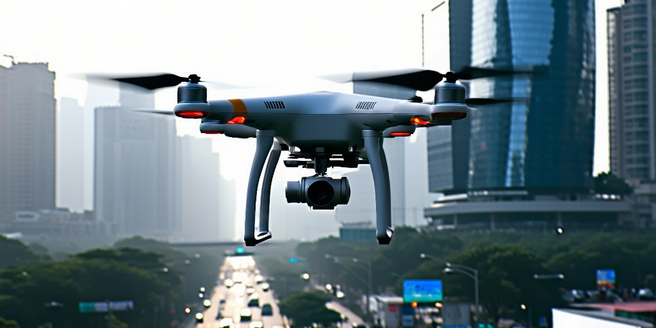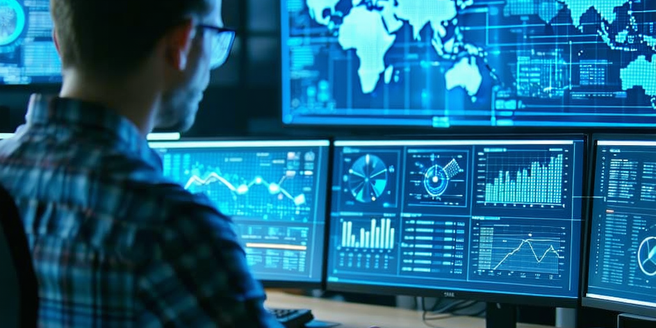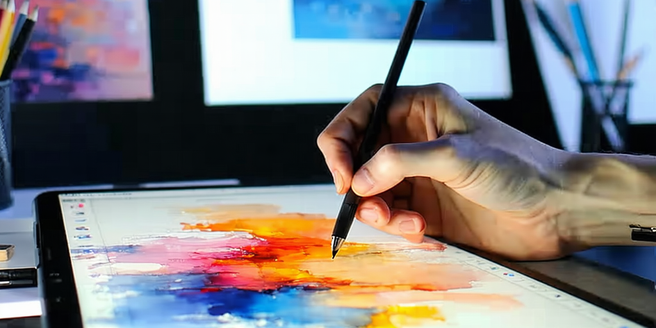
Drone Delivery Systems
Drone technology has rapidly transformed delivery systems, evolving from its initial military applications to a key player in parcel logistics. Pioneered by companies like Amazon and Google, drone deliveries promise faster transit and reduced costs. With advanced navigation systems and improved battery tech, UAVs can autonomously deliver packages with increased range and payload capacity. Despite regulatory challenges and safety concerns, the potential for drones in logistics is significant, driven by key players and innovations. Environmental benefits are notable, as drones reduce greenhouse emissions, offering a sustainable alternative to traditional delivery methods. The role of AI is crucial in enhancing drone efficiency, optimizing navigation and predictive maintenance. As regulations and technology advance, drones are set to become an integral part of the modern logistics landscape.

Ai In Decision-making Processes
Artificial Intelligence (AI) is revolutionizing modern decision-making by enhancing efficiency and accuracy. In decision processes, AI analyzes large datasets swiftly, uncovering insights that improve decision quality with data-driven recommendations tailored to organizational goals. This accelerates decision-making, giving businesses a competitive edge. AI's learning ability means it continually optimizes outcomes. Integrating AI offers benefits like reducing human error and automating routine tasks, allowing focus on strategic initiatives. AI's predictive power helps organizations anticipate trends, enhancing operational efficiency. Despite its advantages, AI presents challenges, including potential bias and over-reliance. Ensuring transparency and data security is vital. Across industries, AI aids decisions in finance, healthcare, retail, and more, demonstrating its transformative impact. Successful case studies, such as cost reduction and improved accuracy in various sectors, highlight AI's potential. The future promises even greater AI integration, propelling strategic decision-making forward.

Blockchain In Supply Chains
Blockchain technology is revolutionizing data handling with its decentralized digital ledger system, enhancing transparency, security, and efficiency. Unlike traditional databases, blockchain records data in immutable blocks linked chronologically, verified through consensus algorithms without a central authority. It is particularly beneficial for applications needing traceability and security, such as supply chain management, by reducing fraud, errors, and inefficiencies. Current supply chain challenges include lack of transparency, fraud, theft, and inefficiencies, which blockchain can address by providing a transparent and tamper-proof record accessible to all stakeholders. By enhancing security with its decentralized structure, blockchain minimizes risks of hacking and unauthorized alterations, securing sensitive supply chain data. Additionally, blockchain streamlines supply chain processes with smart contracts, automating operations and enhancing resource use, leading to faster processing times and cost reductions. Real-world applications show blockchain in action, as seen in global retail for product traceability and pharmaceuticals for authenticating medicine. Understanding blockchain's potential is crucial as it continues to transform industries.

Ai-powered Nutrition And Diet Apps
Artificial Intelligence (AI) is transforming nutrition and dieting by providing personalized dietary recommendations through machine learning algorithms, which analyze complex data to cater to individual nutritional needs. AI can predict optimal nutritional choices faster and more accurately, enhancing decision-making and promoting healthier lifestyle changes. AI-powered nutrition apps offer features like personalized meal planning and real-time data synchronization with wearable devices, simplifying dietary management. They enable users to track progress and receive instant nutrition information. Benefits of AI in dietary planning include tailored nutrition plans based on personal health data, improved diet adherence, and optimizing nutritional intake by identifying deficiencies or excesses. AI personalizes meal recommendations by analyzing user-specific data and continuously refining suggestions. Comparing AI nutrition apps highlights features like genetic-based nutrition analysis and coaching support, with differences in user interface, subscription models, and food database quality. AI is essential for modern diet planning and health management, offering convenience and precision.

Affordable Laptops With Ssd Storage Options
optimize space and performance. It's also wise to disable unnecessary system functions like disk indexing, which can reduce the drive's lifespan. Additionally, overprovisioning, or allocating extra space on the SSD that is unused, can help spread out wear and increase longevity. Lastly, use power management settings that reduce unnecessary read/write operations, especially when your laptop is idle. By following these practices, you can ensure that your SSD remains efficient and reliable over time, providing lasting performance for your laptop.

Top Ipad Accessories For Digital Artists
Discover the essential tools for digital artists seeking precision and efficient workflows. Stylus pens like the Apple Pencil offer pressure sensitivity, tilt features, and palm rejection for a seamless drawing experience that mirrors traditional media. Protective cases safeguard your iPad against damage with durable, shock-absorbent materials, ensuring uninterrupted creativity. Enhance your setup with screen protectors that provide clarity and durability, reducing glare while preserving screen integrity. Wireless keyboards boost productivity by allowing quick access to shortcuts, ideal for transitioning between tasks. Lastly, portable chargers keep your iPad powered during extended sessions, ensuring your creative flow remains uninterrupted. Equip yourself with these indispensable accessories to maximize your iPad’s capabilities and elevate your artistic journey.

Smart Home Device Trends
The smart home industry is rapidly advancing with emerging technologies that enhance convenience and efficiency. Devices are leveraging AI, IoT, and machine learning to become more intuitive, with features such as smart thermostats that learn user preferences and voice assistants that control integrated home systems. The Matter protocol is promoting interoperability between different brands, while 5G technology ensures faster connectivity. Sensor advancements offer precise monitoring for applications like water leak detection and energy optimization. AI-powered home assistants are revolutionizing home interaction by managing tasks and learning user preferences, becoming crucial hubs in smart homes. Sustainability and energy efficiency are prioritized, with smart devices optimizing energy use and integrating renewable sources for eco-friendly living. Security innovations in smart homes include smart locks and cameras with features like facial recognition and real-time alerts, ensuring safety and privacy. The focus on interoperability, led by the Matter protocol, is enabling seamless communication between devices from different manufacturers, fostering innovation and enhancing user experience.

Cloud Storage Changing Photo Sharing
Photo sharing has significantly evolved from physical prints to digital platforms like Flickr and Photobucket, which introduced online image sharing. Social media further transformed photo sharing into a social interaction tool, enhanced by mobile technology allowing instant photo uploads. Today, trends in photo sharing emphasize immediacy, personalization, and user experience, with cloud storage adding flexibility, accessibility, and security. Cloud storage has become crucial in modern photography, offering convenient access, easing collaboration, and mitigating physical storage limitations and data loss risks. By providing scalable storage and advanced tools, cloud solutions facilitate seamless photo management and sharing. However, they also present security and privacy challenges that require careful navigation and understanding of data control. Looking forward, the integration of AI and machine learning is expected to revolutionize photo organization, while advancements in data safety will address privacy concerns, driving the future of cloud storage and photo sharing.

Budget Smartphones Guide
Budget smartphones have evolved significantly, offering features once exclusive to high-end models. Key considerations when choosing a budget smartphone include high-resolution displays, decent camera setups, sufficient processing power, and long battery life. Top brands like Xiaomi, Samsung, Realme, Motorola, and Nokia provide excellent value through reliable and feature-rich devices. Options under $200, such as the Motorola Moto E series and Xiaomi Redmi series, deliver quality without high prices. Battery life and performance are crucial, with many models featuring large batteries and efficient processors. Most budget smartphones run on Android, allowing for custom interfaces and regular updates. When purchasing a budget smartphone, balance features, performance, and price to find a device that meets your needs without exceeding your budget.

Nanotechnology In Medicine
Nanotechnology involves manipulating matter at an atomic scale, offering unique properties that revolutionize fields like medicine, electronics, and materials science. In medicine, it enhances drug delivery, reduces side effects, improves diagnostics, and aids in regenerative medicine and cancer treatment. Nanotechnology's benefits for disease diagnosis include early detection and point-of-care testing, improving accessibility. However, challenges such as safety, regulatory frameworks, cost, and ethical concerns need to be addressed. The future of nanotechnology in medical treatments promises advancements in drug delivery and gene therapy, transforming healthcare.

Voice-controlled Devices
Voice-controlled technology is rapidly enhancing modern living by offering ease and efficiency through voice commands. Utilizing advanced algorithms, voice-controlled devices like smart speakers and voice-activated lights convert speech into machine-understood commands, meeting the increasing demand for hands-free interaction. This technology improves multitasking and accessibility, aiding personal productivity and users with disabilities. Voice-activated devices detect and interpret speech using microphones, AI-driven speech recognition, and cloud-based processing, ensuring enhanced accuracy and function. The evolution of voice recognition, powered by machine learning and natural language processing, now provides human-like understanding across various applications. With benefits like hands-free operation and smart home integration, voice-controlled devices streamline tasks in sectors like healthcare and automotive. Popular products include Amazon Echo, Google Home, and Apple HomePod, featuring virtual assistants for seamless digital interaction.
